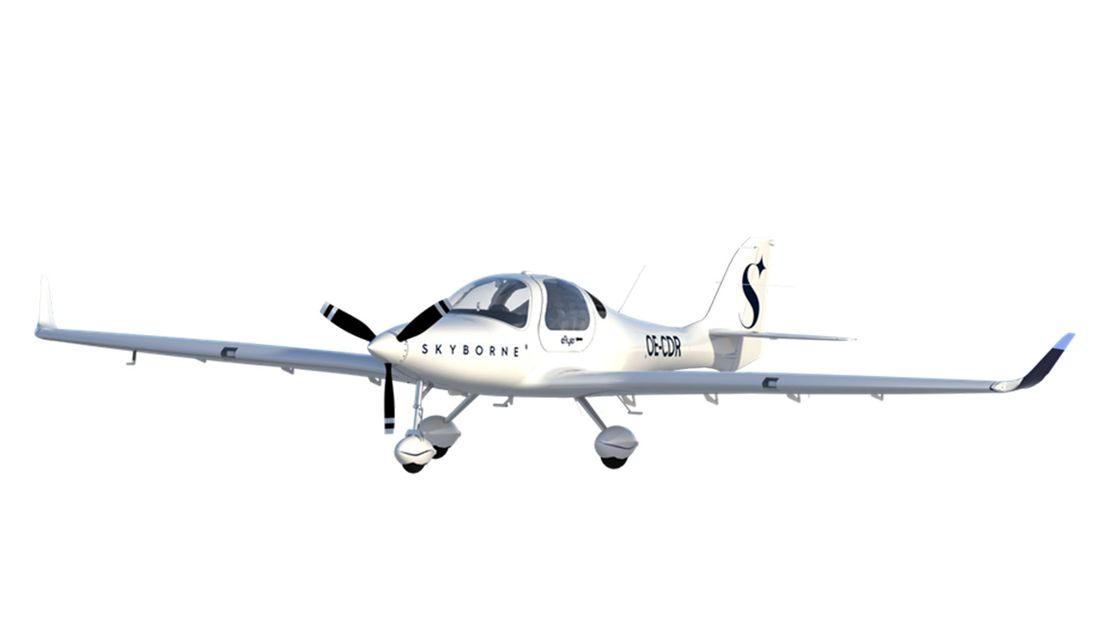The electric plane offers great hope for the diffusion and democratization of private flights. Its operating costs are three to four times lower than that of an aircraft with a combustion engine. The electric motor is almost maintenance-free, and it costs about five times less to use electricity than fuel to travel the same distance. What’s more, the electric motor delivers all its power very quickly, allowing for faster take-offs. Add to this that it is very quiet, and you will see why electric planes will be able to use any kind of small airport very close to big cities.
So far, quite a few electric airplanes have been delivered to flight schools, which find their operating cost and ease of piloting ideal for training future pilots.
British flight school orders ten eFlyers
The British flight school Skyborne Airline Academy has ordered six eFlyer 2 and four eFlyer 4 from Bye Aerospace. The electric aircraft are intended to complement the fleet of training aircraft.

Record flight planned with Velis Electro
German and Swiss electric flight pioneers are planning a record flight with the fully electric Pipistrel Velis from the Alps to the North Sea. Several world records established by aircraft with combustion engines.are to be surpassed by this electric flight.
From August 30th to September 1st, a group of pilots and electric flight enthusiasts around the futurologist Morell Westermann want to undertake a record flight from the Alps to the North Sea with the purely electrically powered Velis Electro, from the Slovenian aircraft manufacturer Pipistrel. Among others, the Swiss pilot Marco Buholzer, who claims to be the head of the only electric flight school in the world, will be there.
In June of this year, EASA certified the Velis Electro from the Slovenian manufacturer Pipistrel, the first purely electrically powered aircraft. The certification is the decisive step from the prototype and experimental stage to commercial use by flight schools and sports pilots.
The route is to be flown in several sections, as the batteries for the electric drive have to be charged several times. As a first step, the team therefore had to find small sports airfields along the route that even had the necessary three-phase current connection with at best 22 kW. This means that the batteries can be charged with a range of around 100 kilometers per hour. Since none of the airfields on the route has a suitable charger, they have to be brought to the aircraft by a ground crew during the world record flight. The company Tesla provides the right vehicles for this.
“Most small aircraft often fly routes that are shorter than 200 kilometers for training or sightseeing. This can already be done electrically without any problems,” says Westermann, co-pilot and spokesman for the company. After all, all the advantages of electric cars would also come into play in aviation. The very quiet and powerful drive enables high climbing performance. In addition, an electric plane can hardly be heard from a distance of around 150 meters. However, electromobility also poses major challenges for the pilots: The lower energy density in combination with the weight of the batteries leads to realistic ranges of around 100 kilometers, the previously non-existent charging infrastructure makes this endeavour a real challenge.
Passenger flights without a combustion engine
“We want to show that passenger flights without a combustion engine are also possible. Even if we don’t manage the entire route in one go, CO₂-neutral flying is already possible today!” Emphasized Westermann. In order to cover the estimated costs of around 80,000 euros, the project is still looking for sponsors. The world record flight is scheduled to take off from Schänis airfield in Switzerland on August 30, then via Zurich, Mainz and Münster and end on September 1 at Norderney airfield. The exact route can be viewed at https://elektro-weltrekordflug.eu/route.
The seven world record attempts at a glance:
- Lowest energy consumption (kWh / 100 km) over 700 km
- Highest average speed over 700 km (km / h)
- Highest flight altitude ever reached with an electric aircraft (meter above main sea level)
- Fastest climbing performance from 0 – 1000 m / 1000 – 2000 m / 2000 – 3000 m (m / s)
- Fastest average speed over 100 km (km / h)
- Smallest number of intermediate stops over a distance of 700 km (number of stops)
- Longest electrically flown route in 24/48/56 hours (km)


